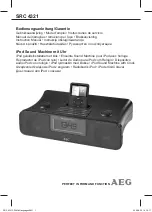
22
should then be displayed on the Weather Station. Also, the signal reception icon will be
displayed. If this does not happen after 2 minutes, the batteries will need to be
removed from both units and reset from step 1.
5.
Insert the batteries in the second transmitter as soon as the outdoor temperature and
humidity readings from the first transmitter are displayed on the Weather Station.
Note :
User shall insert the batteries into the second transmitter within 45 seconds
after the Weather Station displays the information of the first transmitter.
6.
The outdoor temperature and humidity from the second transmitter and the "channel 2"
icon should then be displayed on the Weather Station. If this does not happen after 2
minutes, the batteries will need to be removed from all the units and reset from step 1.
7.
Insert the batteries in the third transmitter as soon as the "channel 2" icon and outdoor
data are displayed on the Weather Station. Then within 2 minutes, the channel 3
outdoor data from the third transmitter will be displayed and the channel icon will shift
back to "1" once the third transmitter is successfully received. If this is not happen, user
shall restart the setting up from step 1.
Note :
User shall insert the batteries into the third transmitter within 45 seconds after
the Weather Station displays the information of the first transmitter. Or immediately
after reception of the second transmitter is finished.
8.
In order to ensure sufficient 868 MHz transmission however, the distance between the
Weather Station and the transmitter should not be more than 100 meters (see notes on
“
Positioning” and “868 MHz Reception
”).
IMPORTANT:
Transmission problems will arise if the setting for additional sensors is not followed as
described above. Should transmission problems occur, it is necessary to remove the
batteries from all units and start again the set-up from step 1.
RESETTING
The Weather Station and the Thermo-hygro transmitter need to be reset when one of the
following conditions occur:
•
Unsuccessful 868MHz signal reception.
•
Malfunction on the units.
•
Batteries replacement.
For resetting, remove all batteries from the units. Wait at least for 1 minute before powering
up the Weather station again. Proceed from step 1 in
“Setting Up”
.
DCF RADIO CONTROLLED TIME
The time base for the radio controlled time is a Cesium Atomic Clock operated by the
Physikalisch Technische Bundesanstalt Braunschweig which has a time deviation of less
than one second in one million years. The time is coded and transmitted from Mainflingen
near Frankfurt via frequency signal DCF-77 (77.5 kHz) and has a transmitting range of
approximately 1,500 km. Your radio-controlled Weather Station receives this signal and
converts it to show the precise time in summer or wintertime.
The quality of the reception depends greatly on the geographic location. In normal cases,
there should be no reception problems within a 1500km radius of Frankfurt.
DCF reception is done twice daily at 02:00 and 03:00 am. If the reception is not successful at
03:00 am, then the next reception takes place the next hour and so on until 06:00am, or until
the reception is successful. If the reception is not successful at 06:00 am, then the next
attempt will take place the next day at 02:00 am.
Once the outdoor data reception test period is completed, the DCF tower icon in the clock
display will start flashing in the upper left corner. This indicates that the clock has detected
that there is a radio signal present and is trying to receive it. When the time code is received,
the DCF tower becomes permanently lit and the time will be displayed.


































